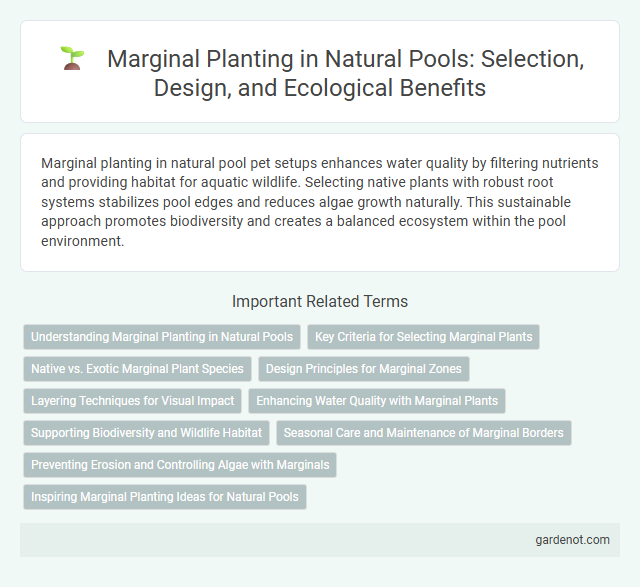Marginal planting in natural pool pet setups enhances water quality by filtering nutrients and providing habitat for aquatic wildlife. Selecting native plants with robust root systems stabilizes pool edges and reduces algae growth naturally. This sustainable approach promotes biodiversity and creates a balanced ecosystem within the pool environment.
Understanding Marginal Planting in Natural Pools
Marginal planting in natural pools involves selecting and placing aquatic plants along the pool's edge to enhance water filtration and provide habitat for beneficial wildlife. These plants, such as reeds, cattails, and sedges, play a crucial role in stabilizing the pool's bank, reducing erosion, and improving water quality by absorbing nutrients and filtering contaminants. Proper understanding of marginal planting ensures a balanced ecosystem that supports biodiversity and maintains the natural pool's ecological health.
Key Criteria for Selecting Marginal Plants
Selecting marginal plants for a natural pool requires prioritizing species that thrive in waterlogged soils and fluctuating water levels while enhancing filtration and habitat diversity. Key criteria include tolerance to wet conditions, root structure strength for bank stabilization, and the ability to absorb excess nutrients to prevent algae growth. Native plants with shallow roots, such as sedges and rushes, are ideal for creating a balanced, sustainable ecosystem along pool margins.
Native vs. Exotic Marginal Plant Species
Marginal planting in natural pools enhances water quality and provides habitat for aquatic wildlife, with native marginal plant species offering optimal ecological benefits due to their adaptation to local conditions and support for biodiversity. Exotic marginal plant species may outcompete native flora, leading to reduced ecosystem stability and potential invasive behavior. Selecting native plants such as Carex, Juncus, and Schoenoplectus ensures effective nutrient filtration and creates a balanced, sustainable marginal planting zone.
Design Principles for Marginal Zones
Marginal planting in natural pools emphasizes native aquatic plants that stabilize soil, filter water, and create habitat for wildlife, enhancing ecological balance. Design principles prioritize selecting plant species with varying root depths to prevent erosion and improve water clarity through natural filtration. Strategically placed marginal zones support biodiversity while maintaining aesthetic harmony and water quality in sustainable swimming ecosystems.
Layering Techniques for Visual Impact
Marginal planting in natural pools uses strategic layering techniques to create striking visual impact and enhance ecological function. Combining tall emergent plants with medium-height and ground-cover species forms dynamic, textured margins that support biodiversity and improve water quality. This layered approach not only stabilizes pool edges but also adds depth and vibrancy to the aquatic landscape, attracting wildlife and ensuring a balanced ecosystem.
Enhancing Water Quality with Marginal Plants
Marginal plants play a crucial role in enhancing water quality in natural pools by filtering pollutants and absorbing excess nutrients. Species like cattails, water irises, and pickerel weed create a natural biofilter that reduces algae growth and maintains clear, balanced water. This ecological approach supports a healthy aquatic environment while promoting biodiversity.
Supporting Biodiversity and Wildlife Habitat
Marginal planting around natural pools enhances biodiversity by providing essential habitats for amphibians, insects, and birds. These plants stabilize the water's edge, filter pollutants, and create a diverse ecosystem that supports natural pest control and pollination. Incorporating native species such as water lilies, reeds, and rushes promotes ecological balance and fosters a thriving wildlife habitat.
Seasonal Care and Maintenance of Marginal Borders
Seasonal care and maintenance of marginal planting in natural pools involve regular pruning to prevent overgrowth and promote healthy plant development. Removing dead or decaying foliage in spring enhances water quality and supports biodiversity along the marginal borders. Monitoring nutrient levels and controlling algae through targeted plant management ensure the ecological balance of the pool is maintained year-round.
Preventing Erosion and Controlling Algae with Marginals
Marginal planting in natural pools plays a crucial role in preventing erosion by stabilizing the pool edges with deep-rooted plants such as carex and cattails, which bind the soil effectively. These plants create a natural filtration system that absorbs excess nutrients, thereby controlling algae growth and maintaining clear water. Incorporating a diverse range of marginal species enhances habitat complexity and supports a balanced aquatic ecosystem.
Inspiring Marginal Planting Ideas for Natural Pools
Marginal planting in natural pools enhances water quality by filtering nutrients and providing habitat for aquatic wildlife. Choosing native species like cattails, sedges, and water irises creates a balanced ecosystem and visually appealing shoreline. Incorporating diverse plant heights and textures promotes biodiversity while stabilizing pool edges and reducing erosion.
Marginal planting Infographic

 gardenot.com
gardenot.com